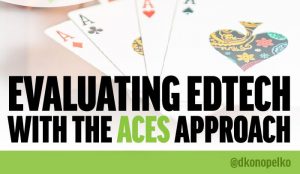TL;DR:
- Assessing Content in Education Systems (ACES) is a strategy for evaluating educational content created by the author of this post.
- ACES is based on four key spectrums: active or anchored, creation or consumption, educational or entertainment, and social or solo.
Knowing how to assess content is a foundational skill, especially because the technical aspects change often in our fast-paced world.
As an educational technology leader, I am often asked to evaluate content to help educators and leaders decide what to adopt. This involves talking about compliance, data privacy, interoperability, standards alignment, and, of course, costs.
These factors are certainly important to making informed district-wide decisions around content adoption, integration, and use. However, they mostly focus on the logistics—the what and how aspects of educational content. By focusing on these factors alone, educators and administrators fail to address the basics: the purpose of a specific product, the expected outcomes from using it, and the educational experience they’re trying to create for their students.
Educators should be intentional about what content or products they introduce in their classrooms. Before implementing a new tool, they should ensure that it aligns with their desired education experience. Share on X
Educators should be intentional about what content or products they introduce in their classrooms. Before implementing a new tool, they should ensure that it aligns with their desired education experience. This includes alignment with instructional goals and how that resource plays out in the classroom during their lessons with their actual students and support staff.
The Aces Approach

Image adapted from: https://unsplash.com/@markwilliamspics
To better assist teachers and administrators going through this process, I came up with a strategy for evaluating educational content. Assessing Content in Education Systems, or ACES, is a great jumping-off point for discussing content and the role it plays in the curriculum. It helps educators look at content as if it were on a spectrum—not a diametrically opposed world of good and evil, but one that is flexible and focused on the student experience.
ACES is based on four key spectrums: active or anchored, creation or consumption, educational or entertainment, and social or solo. I’ve outlined them as questions below for educators to reflect on as they evaluate new content and tools.
Evaluating EdTech: #1 – Does the Content Require a Student to be Active or Anchored?
This question is all about the physical aspect of the experience you’re trying to build. As you’re planning your lesson and thinking about learning objectives, consider movement and motion. Are you creating an experience that keeps kids in their seats or requires them to be up and moving? Which one would enhance the learning experience for your students? Which would best help them grasp the concepts you’re teaching?
Evaluating EdTech: #2 – Does the Content Promote Creation or Consumption?
Think about the different ways a tool might encourage students to create something from scratch or passively absorb knowledge. There are plenty of educational tools that are flexible enough for students to do both. For instance, Nearpod is a great online tool that enables teachers to present information to students in an engaging way. It can also be used to foster creativity. Some educators have students produce and present their own Nearpod lessons, allowing for a completely different learning experience.
It’s also important to remember that even though helping students become active creators is a crucial goal, consuming content is still necessary. We all do it each and every day. Being a smart consumer and curator of information is critical to developing a deep understanding. Once you understand the content, you can begin to innovate.
Evaluating EdTech: #3 – Does the Content Focus on Education or Entertainment?
This question will get you thinking about the primary purpose behind the content or product you’re evaluating. However, the answers aren’t always so clear. As educators continue to look for ways to motivate and engage students, the line between education and entertainment blurs. Today, there’s content that’s clearly based around education with entertainment as an add-on and vice versa. Consider educational apps that gamify learning, such as Kahoot, that can really bring learning to life. Again, there is no right or wrong when it comes to this spectrum; it all depends on what kind of experience you’re trying to create for your students.
[scroll down to keep reading]
Evaluating EdTech: #4 – Does the Content Require Social Interaction or Is It Completed Solo?
Last but not least, ask yourself whether there’s an aspect of the content or product you’re evaluating that will require students to work by themselves or with others. Some classes or lessons may benefit more from one tactic than the other. It’s also important to think about learning objectives here; for example, if the goal is to get students to gain independence in problem-solving and practice self-reflection, basing an activity on a Zoom breakout room may not be the way to go. Introducing the use of a digital notebook may be the better option.
Knowing how to evaluate educational content is a foundational skill, especially because the technical side changes often in our fast-paced world. Before getting down into the nitty-gritty of data sharing or platform access, it’s crucial for educators to prioritize and reflect on the learning experience they want their students to have—from what kind of interactions they want their students to have to how they should feel when using that content or product in the classroom.
About Doug Konopelko
Doug is a passionate educator, designer, writer, speaker, and leader. He focuses on acting as a connecting point between people, ideas, and solutions. On his education journey, Doug has served in both urban and suburban school districts as a teacher, adjunct faculty member, edtech consultant, high school assistant principal, school district administrator, and state education organization leader.


